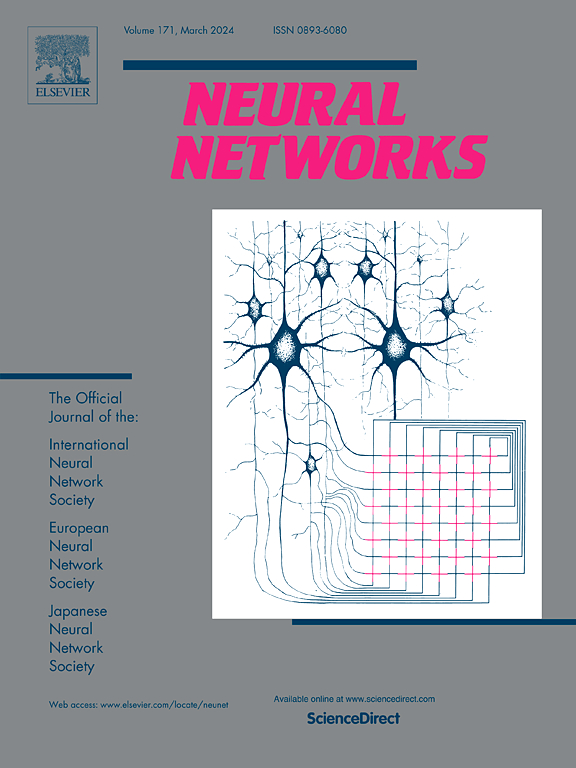Learning performance of cerebellar circuit depends on diversity and chaoticity of spiking patterns in granule cells: A simulation study
IF 6
1区 计算机科学
Q1 COMPUTER SCIENCE, ARTIFICIAL INTELLIGENCE
引用次数: 0
Abstract
The cerebellum, composed of numerous neurons, plays various roles in motor control. Although it is functionally subdivided, the cerebellar cortex has a canonical structural pattern in neuronal circuits including a recurrent circuit pattern formed by granule cells (GrCs) and Golgi cells (GoCs). The canonical circuital pattern suggests the existence of a fundamental computational algorithm, although it remains unclear. Modeling and simulation studies are useful for verifying hypotheses about complex systems. Previous models have shown that they could reproduced the neurophysiological data of the cerebellum; however, the dynamic characteristics of the system have not been fully elucidated. Understanding the dynamic characteristics of the circuital pattern is necessary to reveal the computational algorithm embedded in the circuit. This study conducted numerical simulations using the cerebellar circuit model to investigate dynamic characteristics in a simplified model of cerebellar microcircuits. First, the diversity and chaoticity of the patterns of spike trains generated from GrCs depending on the synaptic strength between the GrCs and GoCs were investigated based on cluster analysis and the Lyapunov exponent, respectively. Then the effect of synaptic strength on learning tasks was investigated based on the convergence properties of the output signals from Purkinje cells. The synaptic strength for high learning performance was almost consistent with that for the high diversity of the generated patterns and the edge of chaos. These results suggest that the learning performance of the cerebellar circuit depends on the diversity and the chaoticity of the spiking patterns from the GrC–GoC recurrent circuit.
小脑回路的学习性能取决于颗粒细胞中尖峰模式的多样性和混沌性:一个模拟研究
小脑由许多神经元组成,在运动控制中起着不同的作用。尽管小脑皮层在功能上有细分,但其神经元回路具有典型的结构模式,包括由颗粒细胞(GrCs)和高尔基细胞(GoCs)形成的循环回路模式。规范的循环模式表明存在一种基本的计算算法,尽管它仍然不清楚。建模和仿真研究对于验证复杂系统的假设是有用的。先前的模型已经表明,它们可以再现小脑的神经生理数据;然而,该系统的动态特性尚未得到充分的阐明。了解电路图形的动态特性对于揭示电路中嵌入的计算算法是必要的。本研究利用小脑电路模型进行数值模拟,研究小脑微电路简化模型的动态特性。首先,基于聚类分析和Lyapunov指数分别研究了GrCs和GoCs之间突触强度对GrCs产生的脉冲序列模式的多样性和混沌性。基于浦肯野细胞输出信号的收敛特性,研究突触强度对学习任务的影响。高学习性能的突触强度与高生成模式多样性和混沌边缘的突触强度基本一致。这些结果表明,小脑回路的学习性能取决于GrC-GoC循环回路尖峰模式的多样性和混沌性。
本文章由计算机程序翻译,如有差异,请以英文原文为准。
求助全文
约1分钟内获得全文
求助全文
来源期刊

Neural Networks
工程技术-计算机:人工智能
CiteScore
13.90
自引率
7.70%
发文量
425
审稿时长
67 days
期刊介绍:
Neural Networks is a platform that aims to foster an international community of scholars and practitioners interested in neural networks, deep learning, and other approaches to artificial intelligence and machine learning. Our journal invites submissions covering various aspects of neural networks research, from computational neuroscience and cognitive modeling to mathematical analyses and engineering applications. By providing a forum for interdisciplinary discussions between biology and technology, we aim to encourage the development of biologically-inspired artificial intelligence.
 求助内容:
求助内容: 应助结果提醒方式:
应助结果提醒方式:


